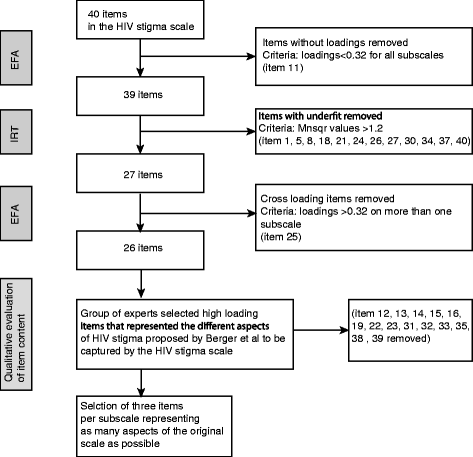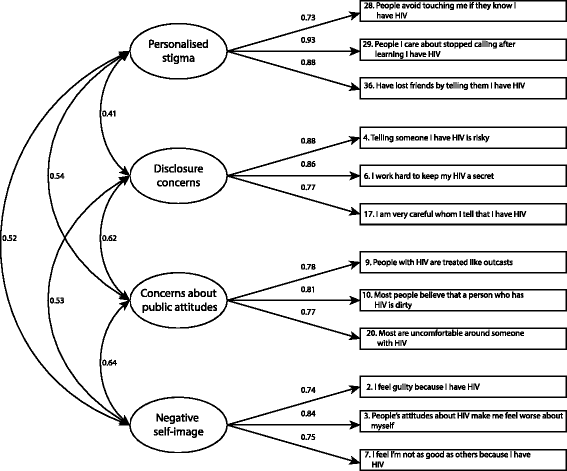Development of a 12-item short version of the HIV stigma scale
- PMID: 28558805
- PMCID: PMC5450123
- DOI: 10.1186/s12955-017-0691-z
Development of a 12-item short version of the HIV stigma scale
Abstract
Background: Valid and reliable instruments for the measurement of enacted, anticipated and internalised stigma in people living with HIV are crucial for mapping trends in the prevalence of HIV-related stigma and tracking the effectiveness of stigma-reducing interventions. Although longer instruments exist, e.g., the commonly used 40-item HIV Stigma Scale by Berger et al., a shorter instrument would be preferable to facilitate the inclusion of HIV stigma in more and broader surveys. Therefore, the aim of this work was to develop a substantially shorter, but still valid, version of the HIV Stigma Scale.
Methods: Data from a psychometric evaluation of the Swedish 40-item HIV Stigma Scale were reanalysed to create a short version with 12 items (three from each of the four stigma subscales: personalised stigma, disclosure concerns, concerns with public attitudes and negative self-image). The short version of the HIV stigma scale was then psychometrically tested using data from a national survey investigating stigma and quality of life among people living with HIV in Sweden (n = 880, mean age 47.9 years, 26% female).
Results: The hypothesized factor structure of the proposed short version was replicated in exploratory factor analysis without cross loadings and confirmatory factor analysis supported construct validity with high standardised effects (>0.7) of items on the intended scales. The χ2 test was statistically significant (χ2 = 154.2, df = 48, p < 0.001), but alternate fit measures indicated acceptable fit (comparative fit index: 0.963, Tucker-Lewis index: 0.950 and root mean square error of approximation: 0.071). Corrected item-total correlation coefficients were >0.4 for all items, with a variation indicating that the broadness of the concept of stigma had been captured. All but two aspects of HIV-related stigma that the instrument is intended to cover were captured by the selected items in the short version. The aspects that did not lose any items were judged to have acceptable psychometric properties. The short version of the instrument showed higher floor and ceiling effects than the full-length scale, indicating a loss of sensitivity in the short version. Cronbach's α for the subscales were all >0.7.
Conclusions: Although being less sensitive in measurement, the proposed 12-item short version of the HIV Stigma Scale has comparable psychometric properties to the full-length scale and may be used when a shorter instrument is needed.
Keywords: HIV; Instrument; Nursing; Patient-reported outcome measures; Psychometrics; Short-form; Stigma.
Figures


Similar articles
-
Psychometric evaluation of the HIV stigma scale in a Swedish context.PLoS One. 2014 Dec 18;9(12):e114867. doi: 10.1371/journal.pone.0114867. eCollection 2014. PLoS One. 2014. PMID: 25522127 Free PMC article.
-
Translation and validation of the Short HIV Stigma scale in Brazilian Portuguese.Health Qual Life Outcomes. 2020 Oct 2;18(1):322. doi: 10.1186/s12955-020-01571-1. Health Qual Life Outcomes. 2020. PMID: 33008400 Free PMC article.
-
COVID-19-related stigma among infected people in Sweden; psychometric properties and levels of stigma in two cohorts as measured by a COVID-19 stigma scale.PLoS One. 2023 Jun 21;18(6):e0287341. doi: 10.1371/journal.pone.0287341. eCollection 2023. PLoS One. 2023. PMID: 37343027 Free PMC article.
-
Measurement Instruments Assessing Multi-Faceted Stigma Regarding Sexual and Gender Minorities: A Systematic Review of Psychometric Properties.AIDS Behav. 2024 Jun;28(6):2054-2077. doi: 10.1007/s10461-024-04305-2. Epub 2024 Mar 5. AIDS Behav. 2024. PMID: 38441698
-
Psychometric properties of stigma and discrimination measurement tools for persons living with HIV: a systematic review using the COSMIN methodology.Syst Rev. 2024 Apr 27;13(1):115. doi: 10.1186/s13643-024-02535-y. Syst Rev. 2024. PMID: 38678285 Free PMC article.
Cited by
-
The Role of Self-Efficacy in HIV treatment Adherence and its interaction with psychosocial factors among HIV Positive Adolescents in Transition to Adult Care in Kenya.Vulnerable Child Youth Stud. 2022;17(4):308-319. doi: 10.1080/17450128.2021.1954736. Epub 2021 Aug 23. Vulnerable Child Youth Stud. 2022. PMID: 36439942 Free PMC article.
-
Hopelessness and HIV infection: an exploratory study with a gender-specific perspective.BMC Psychol. 2022 Feb 28;10(1):46. doi: 10.1186/s40359-022-00755-2. BMC Psychol. 2022. PMID: 35227317 Free PMC article.
-
Adaptation and psychometric evaluation of a scale to measure oral pre-exposure prophylaxis-related stigma among key and vulnerable populations in Kenya.J Int AIDS Soc. 2022 Jul;25 Suppl 1(Suppl 1):e25929. doi: 10.1002/jia2.25929. J Int AIDS Soc. 2022. PMID: 35818870 Free PMC article.
-
Factors affecting optimal adherence to antiretroviral therapy and viral suppression amongst HIV-infected prisoners in South Ethiopia: a comparative cross-sectional study.AIDS Res Ther. 2022 Jan 29;19(1):5. doi: 10.1186/s12981-022-00429-4. AIDS Res Ther. 2022. PMID: 35093100 Free PMC article.
-
British Columbia CARMA-CHIWOS Collaboration (BCC3): protocol for a community-collaborative cohort study examining healthy ageing with and for women living with HIV.BMJ Open. 2021 Aug 6;11(8):e046558. doi: 10.1136/bmjopen-2020-046558. BMJ Open. 2021. PMID: 34362800 Free PMC article.
References
-
- Rao D, Chen WT, Pearson CR, Simoni JM, Fredriksen-Goldsen K, Nelson K, et al. Social support mediates the relationship between HIV stigma and depression/quality of life among people living with HIV in Beijing. China. Int J STD AIDS. 2012;23(7):481–4. doi: 10.1258/ijsa.2009.009428. - DOI - PMC - PubMed
MeSH terms
LinkOut - more resources
Full Text Sources
Other Literature Sources
Medical
Miscellaneous

